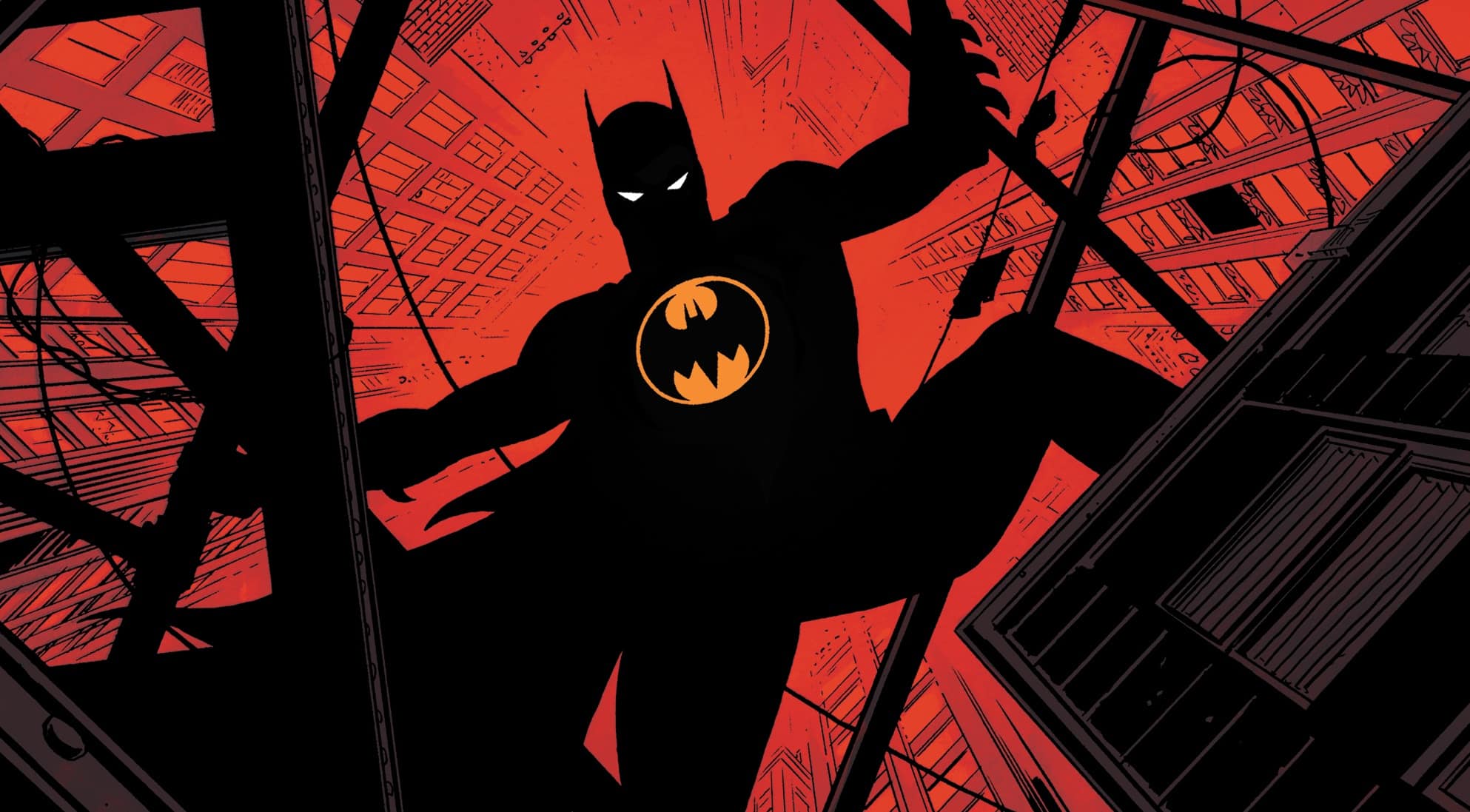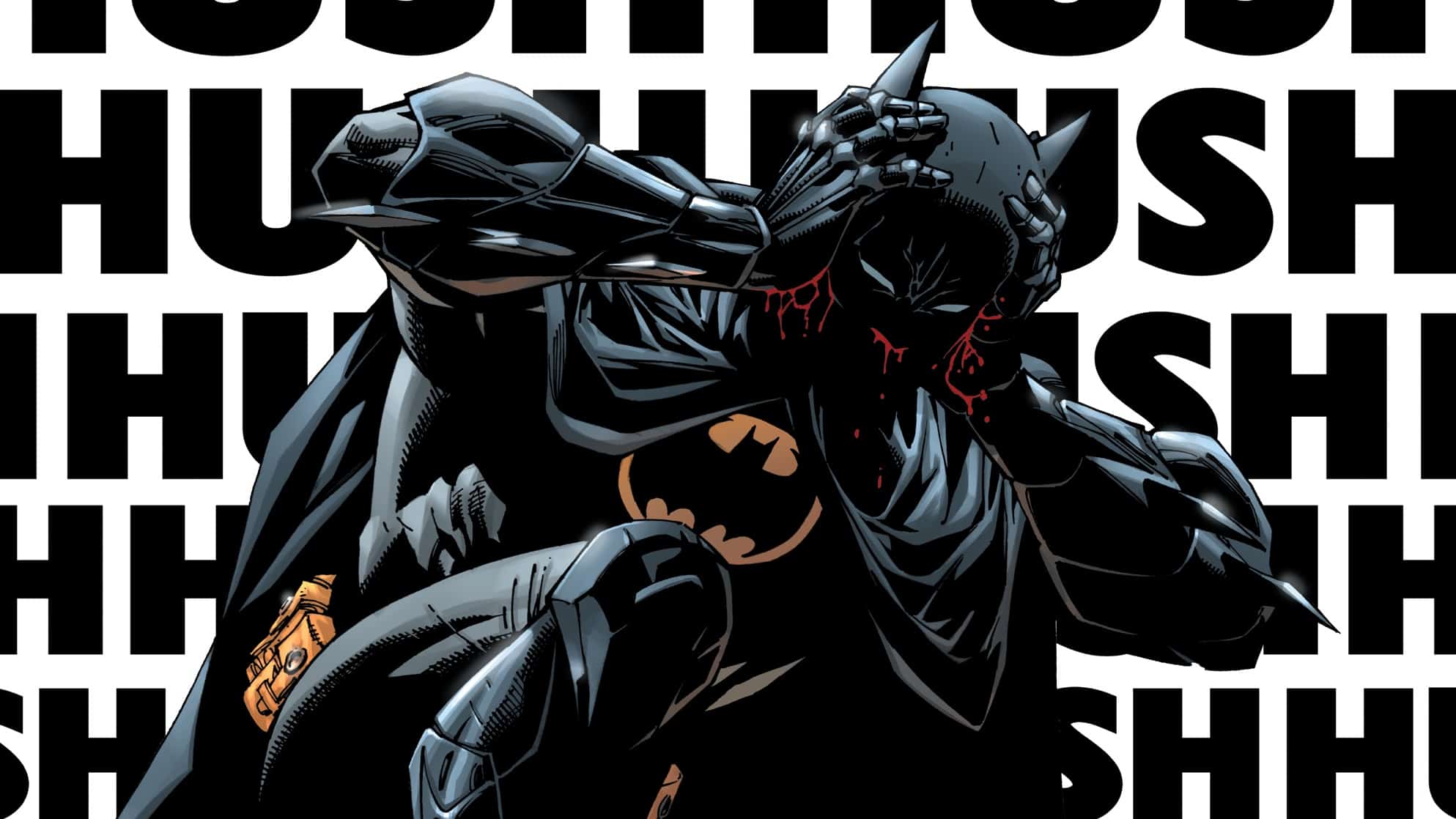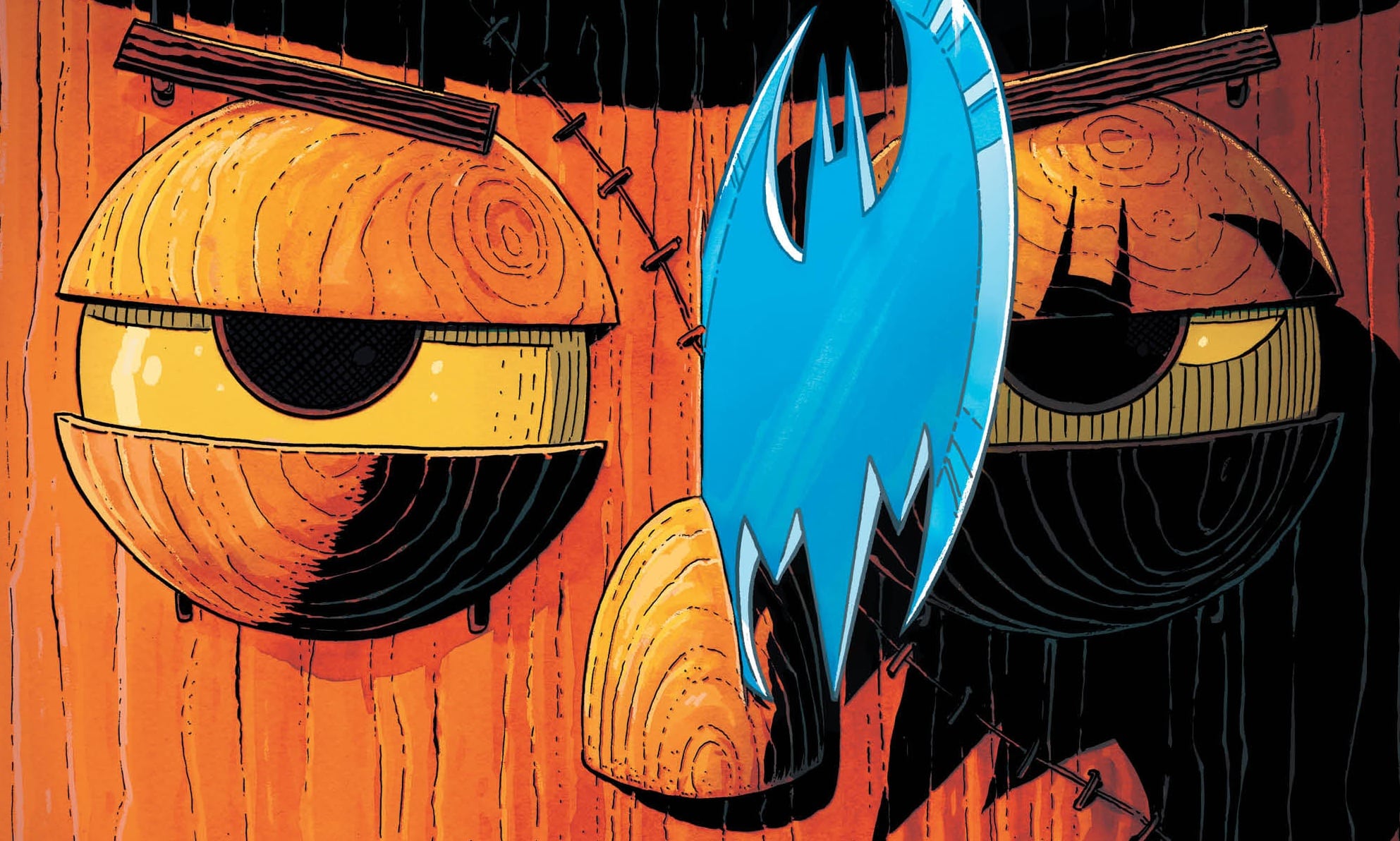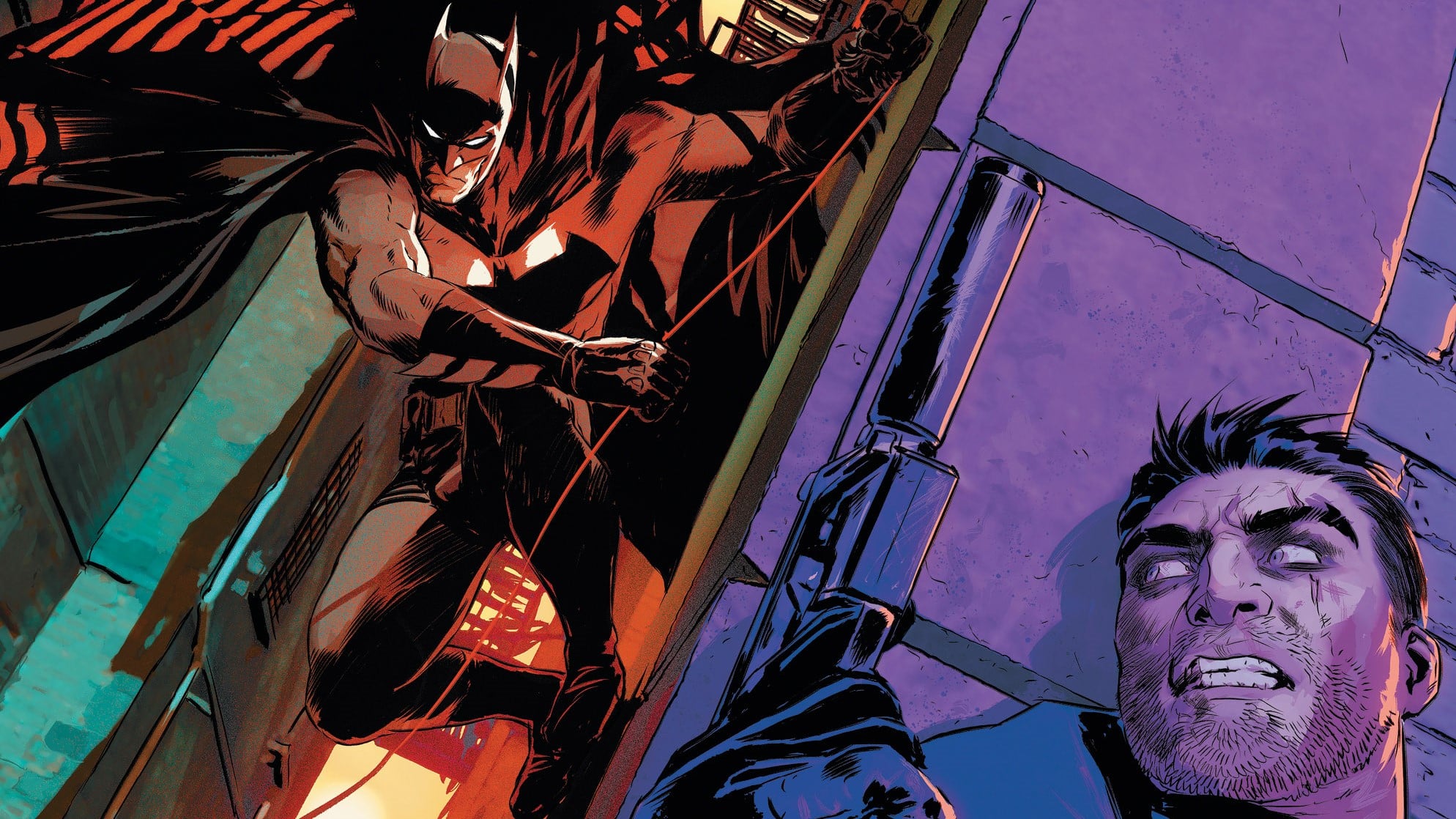“It bounced back and forth in my head until I realized I couldn’t judge it. It was too big. He was too big.“
– Frank Miller, The Dark Knight Returns
“…all stories are, more or less, ghost stories.”
– Julian Woffrey, Victorian Ghosts
Comic books were designed to be inherently disposable. Before collecting exploded into a cottage industry, the only thing keeping most people from throwing out an issue was that they and their friends hadn’t thumbed through it yet, or that their parents hadn’t thrown it out yet. But a version of that outlook still survives among fans when we write off stories as out of continuity, as filler, as trash. Being able to read comics online makes this even easier: You no longer even need to physically buy an issue to throw one away. Comics were always tenuous things – now even more so.
It’s a rare story that calls attention to this – but then, March 1990’s Detective Comics #613, “Trash,” by Alan Grant and Norm Breyfogle, is a rare comic. It’s not a key issue; no character makes their first appearance. I could buy a copy today for about $7. What makes it rare is that it understands itself. It understands how enormous Batman is.
As of 2025, I’d grossly underestimate that Batman has been in 8,548 issues of comics. (That’s the sum of his Golden Age and Earth-2 appearances (611), his Silver and Bronze Age appearances (1,775), those from Crisis to Flashpoint (3,570), and the number since (currently, 2,592).) Grossly underestimating further, at 20 pages a comic, that’s about 170,000 pages of Batman comics over eighty years.
But that number doesn’t quite work. In March 1990, Batmania (sparked by the 1989 film) may have been cresting down – but at its height, as Alan Grant recalled, sales of Detective “shot up to 650,000.” Looking at individual sales, individual copies, the amount of Batman that’s out there soon becomes uncountable, astronomical. In 1989, Batman was mass produced – but eventually, the merchandise, the comics, the games and toys would have to go somewhere. As the kiddies grew up, might Batman himself be thrown away?
It would be far from the first time that had happened, of course. Grant remembered reading Silver Age Batman as a young man and finding something “not quite right” about his “fighting aliens from space and the like.” The Adams/O’Neil era, he remembered, “brought back humanity” to Batman. But Batman had evolved already – and a Batman had already been thrown away to make that happen. When Doctor Wertham had required the vague homoeroticism of Batman and Robin to be chucked away, it would be replaced with the sitcom spaceman of the ‘50s who Alan Grant found somehow off.
That Batman himself eventually evolved into the camp slickster of the ‘60s (he condemned the Blackhawks as “washed-up has-beens” who “just don’t swing!”). Then he became the “hairy-chested love god” of Denny O’Neil and Steve Englehart’s ‘70s, a playboy in a penthouse, and then, finally, the truly dark knight of Frank Miller – as later (unintentionally, perhaps) travestied by Jim Starlin, whose pathologically Reaganite Batman battled drug dealers, the Soviets and the Gotham poor. It was that Batman that Alan Grant was eventually given.
The Batman Alan Grant and Norm Breyfogle were handed, then, was a recycled man (is that a DC villain, the Recycled Man?). Immense amounts of work, of paper, of lead, had gone into building identities for him that were, every ten years or so, thrown away – in that process, how many ideas were thrown away? For a long time, Bat-Mite, Ace the Bat-Hound, and the Bat-Radia were embarrassments to many fans. Even today, the original Jason Todd is just gone (except in “For the Man Who Has Everything” reprints).
But Alan Grant had a long memory – even if they were brought back as “a kind of joke,” one that could potentially go too far, Ace the Bat-Hound and “the Dark Mite” returned in the pages of Grant’s work, and the mute super-mechanic Harold made his entrance, too. (Serious-minded fans’ reaction to this can be grasped by Nightwing’s horror at the sight of a crowded Batcave in the pages of KnightsEnd.)

These would all, have all, come and gone, then come back again. That shouldn’t surprise us: “Batman always comes back, bigger and better, shiny and new. Batman never dies. It never ends. It probably never will.” With those words, Grant Morrison ended their run on Batman, a run based on the central paradox that Batman’s shark-like perpetual motion forwards is both astoundingly inspirational and existentially terrifying. Batman and Robin will never die – and they will never die.
That immortality means that a Batman fan can never read everything – though they can try, like I did. Sometimes, I decide to read all of something: say, all of post-Crisis Batman. By KnightsEnd, I needed to catch my breath. It sometimes seemed as though the DC publication schedule was alive: March, 1992 would grow six new Batman comics, lose two others, and spawn three new titles where Batman might have appeared every time I checked the titles put out that month. (Chain Gang War? Timber Wolf? The Hacker Files?) I started to think I was in a Borges story – except I don’t think Jim Balent drew any comics about Tlön.
Batman’s infinite life ultimately isn’t a biography or even any kind of overarching statement – it’s just infinite. The quote I opened with is, I think, the wisest thing Miller ever wrote about Batman (and my goodness, he wrote quite a lot of unwise things, too). Batman is too big to simply be one kind of thing for everyone. There is too much of him for us to know him fully: that’s the joy of him. For each of us, some legends of the Dark Knight will be, preemptively, legends – or even just trash. But Alan Grant, scribe of the Dark Mite, reminded us that there’s nothing wrong with the unread Batman, unless it falls short of some objective standard of racism or technical incompetence. It’s all Batman, isn’t it?
Denny O’Neil used to say that there was almost no wrong way to write Batman, just differently effective ones. The Batmans we trash, then, aren’t wrong, just different.
But, of course, Alan Grant and Norm Breyfogle’s Batman was different – there’s no getting around it. To them, the Caped Crusader was born through perseverance, through the fact that he had run “the full gamut of human emotions – grief, fear, rage.” Their Batman knew “how people feel.” His parents’ death would make him severe, but not bitter – he would always be a man of “huge compassion.” A short essay Norm Breyfogle wrote about his childhood hero encapsulates the two men’s philosophy of Batman – and it might be the best piece about the character I’ve ever read:
As a child of 10, long before I realized the pen is mightier than the fist, I was so entranced with the Dark Knight that I seriously considered engineering a similar costume and going downtown at night looking for injustices to fight.
Instead, I put it all on paper.
As a fan I saw him as a master of reason, as the ultimate example of a sound mind in a sound body, as a perfected version of what I could become with enough training, as the man most capable of forcing justice and meaning into a resistant world, and as the coolest-looking dude to ever dive off a roof.
As an artist I know him intimately as an ironic subversion of fascism, as a symbolic metaphor for authentic being-in-the-world, as my longest source yet of bread and butter, as my greatest professional old flame, as my astral alter ego, as an ancient dark hero archetype, as pure escapism, and as the Zorro we must all become to save the planet.
He exists only in our imaginations, but the imagination is the lever by which we can move the world, and he’s still the coolest looking dude who ever dove off a roof.
For his part, Alan Grant is probably best known for 2000 AD’s Judge Dredd. Dredd is as cynical a strip as it gets – but it prepared Grant to write this Batman. Dredd is also a subversion of fascism, because functionally, he’s a comedy character: the bitter joke (that has sadly aged very well) is that the Judges are the most unjust thing that could have happened to Mega-City One. But to Grant and Breyfogle, Batman was the best thing to happen to Gotham City. Their Batman is as necessary to his city as electricity or roads. He is Gotham – and Breyfogle’s almost balletically smooth art makes the symbiosis between man and city perfect.

At first, Grant and Breyfogle steered clear of Batman’s classic rogues – these would be stories about “what Batman did on his nights off”. In their run, Batman fought a new oddball villain every month: thanatophile Mortimer Kadaver; his nemesis, the Corrosive Man (the name says it all); always-genteel cannibal Cornelius Stirk; the Ventriloquist and Scarface. Modestly, Grant said he created this new cast because he was unfamiliar with Batman’s new canon. Really, it was because he had mastered the new, and because Breyfogle’s art was perfect for it. 2000 AD was (is) published weekly: each story needed new ideas, new villains, new jokes or else it wouldn’t work. Not every joke or character stuck – but plenty did.
Together, Alan Grant and Norm Breyfogle populated Gotham’s nights with the strange, the weird, the subaltern – Gotham’s “Night People.” Grant and Breyfogle were both intensely political, and in these political stories, their sympathies always lie with the night people. Their great creation, Anarky, is, at his core, an activist – Lonnie Machin is only a villain because the grammar of Batman comics demands it. Their Bruce Wayne cares about the night people. He sponsors classes of underprivileged children; he helps the homeless.
If Grant and Breyfogle’s Batman is like anyone, it’s Will Eisner’s The Spirit, the two-fisted hero of eight-pagers ranging from pure comedy to pure action to pure romance to everything in between. (It ranged, too, to pure minstrelsy. The racism of The Spirit can’t be ignored, even if Eisner eventually acknowledged his deeply racist depiction of the Spirit’s sidekick, Ebony White. For his part, Grant and Breyfogle’s treatment of race, while usually well-intentioned, sometimes landed far closer to Ebony White than the modern reader hopes for.)
At its best, the Spirit was a superhero comic paradoxically not much about its superhero: the Spirit often “took a back seat to the small dramas of losers, dreamers and ordinary joes.” The Spirit was just another citizen of Central City, if a bit more of a fighter and a ladies’ man than the average. His suit ripped, and he even failed: he was only human, after all. Alan Grant, a great admirer of The Spirit, once told The Comics Journal that he thought Eisner was “probably the most creative guy in comics.” (I adore this interview – you could use it to explain ‘taking the piss’ to aliens about to meet British people for the first time.)
Detective Comics #613 isn’t exactly subtle about its Eisner influence, or about anything else. It even opens with a diegetic title card a la Spirit:

Like The Spirit, “Trash” is barely about its superhero at all. Rather, its hero is eighth-grader Mike Dell, hard at work on a class report about the “25,000 tons” of trash spewed out by Gotham City every day.” What, Mike asks, becomes of Gotham’s “bedsteads and plastic bags and toenail clippings and torn comics”? Where does it all go? It’s a question only Alan Grant, writer of the night people, would think to ask.
Mike’s dad Harv is a garbage man. A small operator in a big, bad city, the trash goes to him, and when it does, people like Bruce Wayne, Vicki Vale, and the reader, can forget about it. It’s disappeared. But Grant and Breyfogle never let us forget that this is just passing the hot potato down to someone poorer: it isn’t close to good enough. As Vicki makes a worried Bruce wait before their fashionable lunch, the trash might be invisible, but it hasn’t moved anywhere. Neither has “human trash,” the night people. Gotham’s homeless and Gotham’s villains are right here: out of the corner of his eye, Bruce spots the head of Clayface III’s mannequin lover (long story) in the trash as just so much junk. After Vicki walks out on him, Bruce even steps in chewing gum.
With human trash comes exploitation: here the villainous waste disposal conglomerate enters. KrudCo goons threaten Harv Dell just outside of the posh restaurant. If Mike’s father isn’t “outta here by tonight,” they say, then Mr. Kruden of KrudCo (yes, really) will make sure that he’s “outta here permanent!” The Batman can lipread – and the Batman doesn’t like this. There’s trash right outside, after all.
Shaken, Harv tells Mike he won’t be able to take him to Freshfields – Gotham’s landfill, “an alien world… a planet of trash”: but that night, eager-beaver Mike sneaks on top of the garbage truck anyways, ready to see Freshfields for himself. The sheer thoughtlessness of piled garbage astounds him: “We can’t go on like this! The whole world’ll turn into a trash dump!” Something has to be done, says Mike, “before it’s too late!”
The question of trash is on Batman’s mind, too:

Human trash – sometimes it’s the people society throws away, sometimes it’s the people who throw themselves away. This is the standard reactionary pose of post-Miller Batman, but it’s also Alan Grant’s favorite trick. He made a science out of bookending radicalism with two-fisted action: come for the punching, stay for the agitprop. I don’t mean that dismissively – Breyfogle’s are some of the most perfect punches in comics:

But perfect as the fights are, they accomplish hopelessly little. When Batman tracks KrudCo to Freshfields, Kruden’s already got Harv at gunpoint. Then he has “a better idea” – “a trip through your own grinders!” Mike tries to warn his father but Batman is too late:

In the melee that follows, justice is done; Kruden is even accidentally knocked into the grinder with an “AAAAGGHH!!” It’s the kind of resolution that would make Judge Dredd proud, or even the Batman of the Golden Age, who saw crooks meeting “fitting ends” as a perk of the job. Here, though, it’s hollow:

Batman’s furrowed brow says it just as surely as the captions: “What a waste!” This is Alan Grant’s Batman in miniature – a small, story, unsubtle in the extreme, both ahead of its time and a product of it. But it’s searing stuff: if Gotham breathes, then we have to know the air quality index. It reminds me of Ann Nocenti at her best – that is, at her most unsubtle.
I don’t think this story intentionally comments on DC continuity or the endless life of the World’s Greatest Detective. It’s an environmental call to arms: we have to do something about our trash, before we ourselves become, like poor Mike, just so much human trash. It begs the reader to just notice what they throw away: whether it’s bad food or good food or mangled cats or bedsteads or plastic bags or toenail clippings or torn comics – or what’s inside those torn comics.
Noticing what gets thrown away is a way of looking, a way of thinking, of reading – and it’s a good way to read Batman. If we pay attention to what’s been swept under the carpet of continuity, we’d be able to remember what we have. We’d be better able to understand the racist and exclusionary ideas trapped in the landfill of popular culture. The only way to find is to notice, to look, to remember.
Batman shouldn’t always be the way he is in “Trash” – but all the same, we shouldn’t forget Batman’s nights off. We shouldn’t forget the time he fought for justice in a landfill and failed. What a waste it would be to ignore that. What a waste it would be to ignore Detective Comics #613. What a waste it would be to ignore two of the strangest and greatest Batman creators of all time, Alan Grant and Norm Breyfogle.

Margot Waldman
Margot Waldman is a Mega City Two-based scholar, researcher and writer. Her great loves are old comics, Shakespearean theater and radical social justice – in no particular order. One day, she hopes to visit the 30th century.





